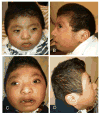Long-term survival in TARP syndrome and confirmation of RBM10 as the disease-causing gene
- PMID: 21910224
- PMCID: PMC3183328
- DOI: 10.1002/ajmg.a.34190
Long-term survival in TARP syndrome and confirmation of RBM10 as the disease-causing gene
Abstract
TARP syndrome, comprising Talipes equinovarus, atrial septal defect (ASD), Robin sequence (micrognathia, glossoptosis, and cleft palate), and persistence of the left superior vena cava, is an X-linked condition with pre- or postnatal lethality in affected males. Based on linkage studies and massively parallel sequencing of X-chromosome exons in two families, the disease-causing gene was identified as RBM10. We identified a maternally inherited frameshift mutation in an unrelated patient, confirming RBM10 as the disease gene. This is the first reported individual with TARP syndrome who survived past early infancy, thus expanding the phenotypic spectrum of this disorder. In addition to the characteristic cleft palate, ASD, and persistent superior vena cava, he had low-set and posteriorly angulated ears, upslanting palpebral fissures, cryptorchidism, and structural brain abnormalities including partial agenesis of the corpus callosum, dysplastic enlarged caudate, and cerebellar hypoplasia with megacisterna magna. Preterm delivery, suspected pulmonary hypoplasia, and pulmonary hypertension resulted in chronic lung disease. At the age of 3(7)/(12) years, he remained ventilator-dependent at night, and he was fed exclusively through a gastro-jejunal tube. Sensorineural hearing loss required a hearing aid. Optic atrophy and cortical visual impairment were noted. He was unable to sit independently, was non-communicative and he had severe intellectual disability. Atrial flutter required recurrent ablation of intra-atrial re-entry pathways. The mother's heterozygosity for the RBM10 mutation underscored the importance of accurate diagnosis and counseling for TARP syndrome.
Copyright © 2011 Wiley-Liss, Inc.
Figures



References
-
- Gorlin RJ, Cervenka J, Anderson RC, Sauk JJ, Bevis WD. Robin's syndrome. A probably X-linked recessive subvariety exhibiting persistence of left superior vena cava and atrial septal defect. Am J Dis Child. 1970;119:176–178. - PubMed
-
- Johnston JJ, Teer JK, Cherukuri PF, Hansen NF, Loftus SK, NIH Intramural Sequencing Center. Chong K, Mullikin JC, Biesecker LG. Massively Parallel Sequencing of Exons on the X Chromosome Identifies RBM10 as the Gene that Causes a Syndromic Form of Cleft Palate. Am J Hum Genet. 2010;86:743–748. - PMC - PubMed
-
- Kurpinski KT, Magyari PA, Gorlin RJ, Ng D, Biesecker LG. Designation of the TARP syndrome and linkage to Xp11.23-q13.3 without samples from affected patients. Am J Med Genet Part A. 2003;120A:1–4. - PubMed
Publication types
MeSH terms
Substances
Supplementary concepts
Grants and funding
LinkOut - more resources
Full Text Sources
Medical
Miscellaneous

